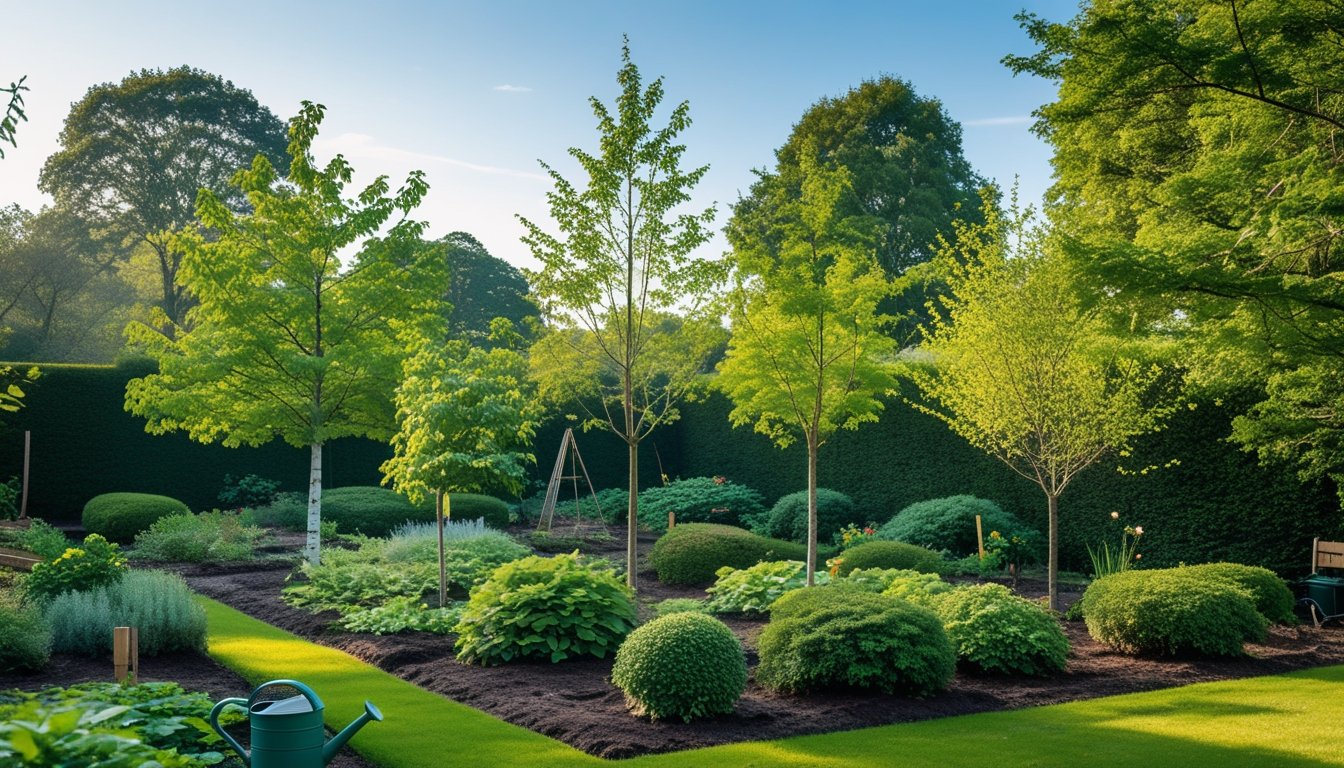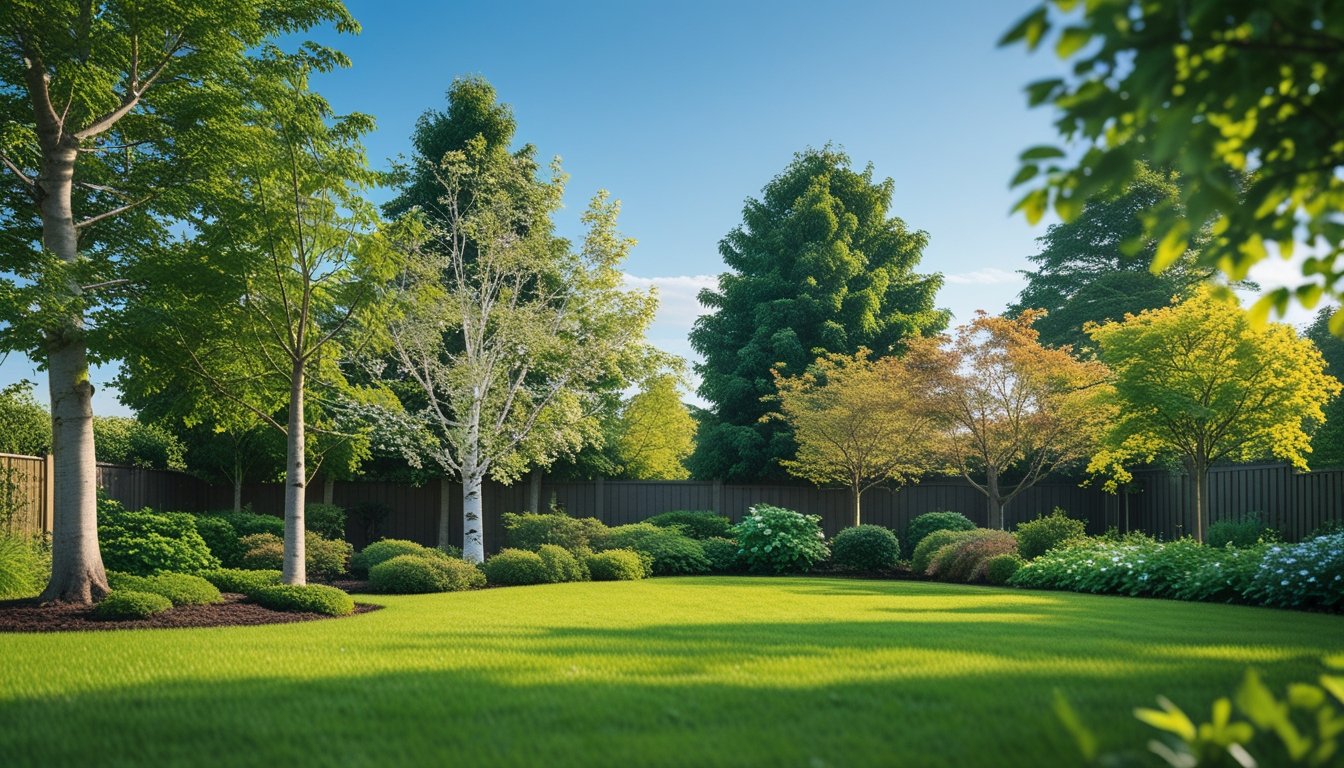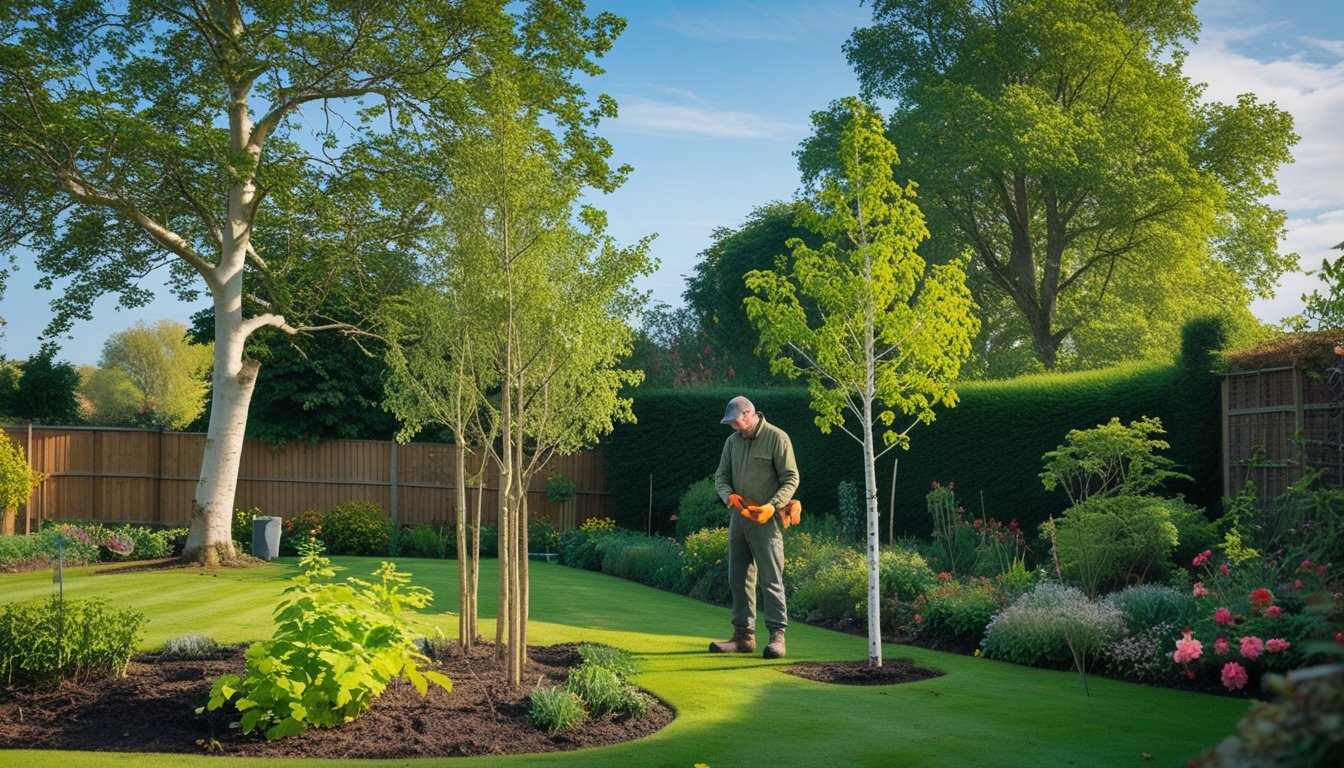Late updated: 24 Jul 2025 15:07
Written by: Emily Thornton
Choosing the Right Native UK Trees for Your Garden: Expert Tips for a Thriving Landscape
Selecting the right native UK trees for our gardens is a decision that combines aesthetics with environmental responsibility. Choosing the appropriate species can transform our gardens into vibrant ecosystems that support local wildlife and add natural beauty to our outdoor spaces. Native trees are well-adapted to local climates, requiring less maintenance and offering a sustainable choice for gardeners aiming to enhance biodiversity.

When planning our garden's layout, we must consider factors such as size, soil type, and the specific needs of the wildlife we aim to attract. With a variety of trees that provide year-round interest, from the bursting blossoms of spring to the rich tapestry of autumn leaves, our choices can significantly impact the visual appeal and health of our gardens. Native trees also tend to be more resilient against pests and diseases, making them an excellent long-term investment for our landscapes.
Whether our space is vast or compact, there's a perfect native tree for every garden. By understanding the available species and their characteristics, we can make informed decisions that benefit both our gardens and the local environment. This thoughtful approach not only enriches our own green spaces but also contributes positively to the broader ecological community.
Key Takeaways
- Native trees enhance garden biodiversity and beauty.
- Consider size, soil, and wildlife needs when selecting trees.
- Native species are resilient and suited for UK gardens.
Key Considerations When Selecting Native UK Trees
Selecting the right native UK trees for our garden involves several key factors, such as garden size and layout, soil type and drainage, local climate conditions, and growth rate. Addressing these considerations ensures that the trees we choose not only thrive but also enhance the ecological value and aesthetic appeal of our space.
Assessing Garden Size and Layout
Understanding the size and layout of our garden is essential when selecting native trees. Smaller gardens might benefit from compact native species like rowan or hawthorn, which provide beauty without overwhelming the space. Large gardens can accommodate more substantial trees, offering options like oak or beech that can provide significant shade and habitat.
We should also consider how trees will fit the overall design. If we wish to use trees as natural screens or focal points, their placement becomes crucial. An elevated planting area might require more height control, while trees in open spaces may grow more freely. Planning the layout with these aspects in mind will ensure a harmonious and functional garden.
Understanding Soil Type and Drainage
Native UK trees thrive when they are matched with suitable soil conditions. Before planting, it's vital to assess the type of soil present in our garden. Sandy soils may benefit species like pine, while clay-rich soils might suit trees such as willow. Loam, being well-balanced, can accommodate a variety of species, including maple or birch.
Drainage is another important factor. Poorly drained areas could lead to root rot in species that prefer drier conditions. Testing soil drainage by using a simple percolation test helps us identify potential challenges and adjust our planting strategy accordingly. Additionally, amending the soil with organic matter may improve drainage and fertility, offering a healthier environment for tree roots.
Matching Trees to Local Climate Conditions
The UK's climate varies, and this affects which native trees will flourish in our particular region. Understanding the local weather patterns helps us choose trees resilient against climatic extremes. For instance, Scots pine is tolerant of colder climates and thrives in Scotland, while ash might be better suited to milder conditions in southern England.
Selecting climate-appropriate trees contributes to long-term health and sustainability. Native species typically have adaptations to local climate stresses, making them lower maintenance and more sustainable choices. By choosing trees that align with the local environment, we enhance our garden’s resilience and ecological integrity.
Growth Rate and Maintenance Requirements
The growth rate of native trees is a pivotal factor in garden planning. Faster-growing species like willow can quickly provide necessary shade or screening but may require more regular maintenance. Slower-growing trees, such as oak, need less frequent pruning but demand more patience to reach maturity.
Maintenance needs also vary among species. Some trees may drop more leaves or require specific care regimes, influencing our dedication to upkeep. Understanding these requirements helps us select trees that match both our aesthetic desires and available maintenance resources. Aligning tree choices with our commitment ensures that the garden remains both beautiful and manageable over time.
Top Native UK Trees for Gardens

Our gardens can be greatly enhanced by selecting native UK trees, which not only beautify outdoor spaces but also support local wildlife. Silver Birch adds striking visuals, Rowan offers year-round interest, Crab Apple provides delightful blossoms and wildlife benefits, while Hawthorn serves as excellent hedging with lovely spring flowers.
Silver Birch (Betula pendula): A Striking Feature Tree
The Silver Birch is well-loved for its striking white bark and graceful, airy appearance. Standing tall, this tree often reaches heights of up to 15-25 metres, making it a splendid feature in any garden. Its leaves turn golden in autumn, offering a seasonal display of colour.
Silver Birch thrives in various conditions, from sandy to clay soils. It is particularly suited for well-drained areas. Beyond its beauty, the tree supports biodiversity by providing food and habitat for insects and birds. As a hardy tree, Silver Birch is resilient against typical UK weather conditions, making it a reliable choice for gardeners seeking a distinctive and eco-friendly addition.
Rowan (Sorbus aucuparia): Year-Round Interest
The Rowan, or Mountain Ash, offers year-round appeal with its lovely clusters of white spring flowers and bright red berries in autumn. Growing to around 10-15 metres, it fits well in small to medium gardens. The berries attract various bird species, turning gardens into vibrant wildlife havens.
One of Rowan’s advantages is its adaptability to diverse conditions, from full sun to semi-shade. Its preference for well-drained soil makes it easy to maintain. With its elegant, pinnate leaves, Rowan adds textural interest throughout the seasons. This tree is also steeped in folklore, often considered a protective symbol in British culture. It is both a practical and charming choice for gardeners.
Crab Apple (Malus sylvestris): Blossom and Wildlife Benefits
The Crab Apple tree is a versatile addition, known for its stunning spring blossom and contribution to wildlife. It grows to about 10 metres, featuring pink or white flowers that brighten any garden. In autumn, it bears small, edible fruit that can be used for making crab apple jelly.
Crab Apples are particularly noted for their ecological benefits. Birds and small mammals are drawn to the fruit, while pollinators feast on its blossoms. Preferring moist and fertile soil, these trees are adaptable to most garden settings. Their relatively compact size makes them ideal for urban or suburban gardens, offering a splash of colour and life to the surroundings.
Hawthorn (Crataegus monogyna): Hedging and Spring Flowers
Hawthorn, or Crataegus monogyna, is commonly used for hedging, valued for its dense growth and seasonal flowers. It can grow up to 10 metres if left untrimmed but is often kept shorter for hedges. The white, fragrant blossoms in spring are followed by red berries, essential for supporting local wildlife.
The tree is particularly useful for forming natural boundaries. Its thorny branches provide excellent protection for nesting birds. Hawthorn thrives in almost any soil type, though it prefers sunny positions. Traditional hedgerows are often made of Hawthorn, reflecting its historical and ecological significance. It remains a practical and attractive choice, blending beauty with functionality in our gardens.
Frequently Asked Questions

Native UK trees are perfect for garden cultivation. They not only support local ecosystems but also offer aesthetic beauty. Housing a variety of functions, these trees can serve small spaces, ensure privacy, and contribute to biodiversity. Identifying them often requires a keen eye and understanding of their unique characteristics.
What are the best native UK trees for small gardens?
Small gardens benefit from trees like the Rowan, Hawthorn, and Silver Birch. These species are compact, manageable, and add seasonal interest. Rowan is favoured for its vibrant berries, while Hawthorn offers lovely spring blossoms. Silver Birch stands out with its delicate leaves and striking bark.
Which native UK trees provide the best privacy in a garden?
For privacy, we can rely on Holly, Yew, and Hornbeam. Holly remains lush year-round and offers red berries. Yew is dense and evergreen, creating a solid barrier. Hornbeam, with its thick foliage, is useful for screens and hedges especially in smaller spaces.
What are the most common native trees found in the UK?
In the UK, Oak, Ash, and Beech are commonly seen across the landscape. Oak is known for its strength and grandeur. Ash typically grows rapidly and is valued for its versatility. Beech, with its smooth bark, is a classic feature of British woodlands.
Can you list native British flowering plants suitable for gardens?
Popular native flowering plants include Foxglove, Primrose, and Bluebell. These plants not only provide colourful blooms but are well-suited to the local climate. Foxglove is famous for attracting pollinators, while Primrose is an early spring favourite. Bluebell carpets can often lead to striking displays in mid-spring.
How can I identify native British trees and plants?
Identification often hinges on examining the leaves, bark, and overall structure of the plant. Leaf shapes, arrangement, and the presence of flowers or fruit can be telling. Resources such as field guides and mobile apps can aid in this process, providing photo references and descriptions.
What should I consider when selecting native British trees for planting?
When selecting trees, factors such as soil type, available space, and sunlight exposure are critical. It's essential to match the tree's needs with your garden conditions. Additionally, considering the tree's growth rate and maximum size can prevent future issues and ensure longevity.
